Note4Students
From UPSC perspective, the following things are important :
Prelims level: Marakkars
Mains level: Various conquests during colonial expansion
The big-budget Malayalam film Marakkar: The Lion of the Arabian Sea is set to be released. It is a war film depicting the heroics of the Marakkar clan, whose leaders were naval chieftains of the Zamorin of Calicut during the 16th and 17th centuries.
Who were the Marakkars?
- By some accounts, they were of Arab origin and had migrated from Tunisia to Panthalayani near Koyilandy in present-day Kozhikode, and later moved to the region around present-day Kottakkal and Thikkodi near Payyoli.
- By other accounts, the Marakkars were descendants of affluent businessman from the Cochin kingdom who migrated later to Calicut.
- Historians say the name ‘Marakkar’ could have originated from maram or marakkalam, meaning ship, as these families lived along the coast and used ships.
- Alternatively, it could have originated from the Arabic word markaba, meaning those who migrated via ships.
- The Marakkars were mostly Muslims, but in some parts, they have been found to be Hindus as well.
What was the war against the Portuguese about?
- The Zamorin, Samoothiri in Malayalam, was the title given to rulers of the Calicut kingdom on the Malabar coast.
- Faced with invading Portuguese ships, the Zamorin reached out to the Marakkars to defend the coast. The Marakkars fought against Portuguese invaders for nearly a century.
- They were led in succession by four Marakkars, chief admirals who were appointed by the Zamorin with the title of Kunjali.
- Related by bloodline, they were Kuttyali Marakkar (Kunjali Marakkar I, appointed in 1507), Kutty Pokker (Kunjali Marakkar II), Pathu Marakkar (Kunjali Marakkar III) and Muhammad Ali Marakkar (Kunjali Marakkar IV, appointed in 1595).
- Their strategy was similar to guerrilla warfare. The Portuguese had massive ships which could not make easy manoeuvres in the sea.
- The Marakkars used small ships which could easily surround the Portuguese ships, enabling the fighters to attack at will.
Who is depicted the ‘Lion of the Arabian Sea’?
- Kunjali Marakkar IV earned his reputation with his fierce onslaught on Portuguese ships, the favours he gave those who fought against the Portuguese, and his efforts to strengthen the fort at Kottakkal.
- When he took charge in 1595, relations between the Zamorin and the Marakkars were deteriorating.
- The Zamorin was feeling threatened by Kunjali Marakkar IV’s popularity, and by reports (said to be spread by the Portuguese) that he was planning to create a Muslim empire.
- In 1597, the Zamorin signed a peace treaty with the Portuguese and attacked Kottakkal fort. For months, the Marakkars resisted the attack by the Zamorin’s Nair soldiers and the Portuguese fleet.
- Eventually, as Portugal sent more forces and the Zamorin mounted his effort, Marakkar surrendered to the Zamorin on the assurance that their lives would be spared. But the Portuguese violated the terms, arrested him, took him to Goa and beheaded him.
Get an IAS/IPS ranker as your 1: 1 personal mentor for UPSC 2024
Attend Now
Note4Students
From UPSC perspective, the following things are important :
Prelims level: N95 Masks
Mains level: Coronovirus outbreak
In a new mandate to curb unnecessary demand, the Maharashtra Food and Drug Administration said that chemists cannot sell N95 masks without a doctor’s prescription. The FDA also warned that serious action would be taken against those who are found selling masks at high prices or hoarding them.
Why such a move?
- Personal Protective Equipment (PPE) kits and N95 masks are being sold at very high prices in medical shops. The State has received many complaints about the same.
- It has also been found that many are making bulk purchases and hording PPE kits and N95 masks.
- Since the COVID-19 outbreak in China, shortage of PPE gear and masks has been reported from across the world.
- While the Indian government has currently banned exports of N95 masks, the manufacturers are focussed on making other surgical marks to get good returns from exports.
N95 mask
- A disposable N95 mask (respirator) is a safety device that covers the nose and mouth and helps protect the wearer from breathing in some hazardous substances.
- An N95 respirator is designed to achieve a very close facial fit and very efficient filtration of airborne particles.
- The ‘N95’ designation means that when subjected to careful testing, the respirator blocks at least 95 percent of very small (0.3 micron) test particles.
- If properly fitted, the filtration capabilities of N95 respirators exceed those of face masks. However, even a properly fitted N95 respirator does not completely eliminate the risk of illness or death.
Get an IAS/IPS ranker as your 1: 1 personal mentor for UPSC 2024
Attend Now
Note4Students
From UPSC perspective, the following things are important :
Prelims level: Amrit Kaur
Mains level: Not Much

Former PM Indira Gandhi and freedom fighter Rajkumari Amrit Kaur are mentioned in TIME magazine’s list of the 100 most powerful women who defined the last century in a new project that aims to feature those women who were “often overshadowed”.
Who was Amrit Kaur?
- Amrit Kaur was the first woman in independent India who joined the Cabinet as the Health Minister and remained in that position for 10 years.
- Born into the Kapurthala royal family, she was educated in Oxford and returned to India in 1918, and began to be drawn towards the work and teachings of MK Gandhi.
Her contributions
- Before taking up the position of a Health Minister, Kaur was Mahatma Gandhi’s secretary.
- During these 10 years, she founded the Indian Council for Child Welfare.
- She also laid the foundation of the All India Institute of Medical Sciences (AIIMS) and Lady Irwin College in Delhi in the following years.
- Apart from joining the nationalist freedom struggle, Kaur also began work on a number of other social and political issues such as the purdah system, child marriage and the Devadasi system.
- She passed away in 1964, at the age of 75.
Role in the freedom struggle
- In 1936, hoping that more women would join the freedom struggle, Gandhiji invited her.
- In the following years, as Kaur started interacting with other freedom fighters such as Gopal Krishna Gokhale and Mahatma Gandhi, she gave up her princely comforts and began to discipline herself by responding to the Gandhian call.
- When the civil disobedience movement took off in the 1930s, Kaur dedicated her life to it.
- Kaur was jailed after the Quit India movement and carried to the jail a spinning wheel, the Bhagwat Gita and the Bible.
- Further, while Kaur advocated for equality, she was not in favour of reservations for women and believed that universal adult franchise would open the doors for women to enter into the legislative and administrative institutions of the country.
- In light of this, she believed that there was no place left for reservation of seats.
Get an IAS/IPS ranker as your 1: 1 personal mentor for UPSC 2024
Attend Now
Note4Students
From UPSC perspective, the following things are important :
Prelims level: Gairsain
Mains level: Two/Three capitals concept

Uttarakhand govt names Gairsain as the new summer capital of the state.
Gairsain
- Gairsain is situated at the eastern edge of the vast Dudhatoli mountain range, located almost at the centre of the state, at a distance of approximately 250 kilometres from Dehradun.
- It is easily accessible from both the Garhwal and the Kumaon divisions, and in a way, acts as the bridge between the two regions.
- Uttarakhand was carved out as a separate state from Uttar Pradesh in 1998.
- Gairsain was best suited to be the capital of the mountainous state as it was a hilly region falling on the border of Kumaon and Garhwal regions.
- But it was Dehradun, located in the plains that served as the temporary capital.
- With the fresh announcement, there is no clarity on either the city’s current status or a new winter capital.
- The state Assembly is located in Dehradun, but sessions are held in Gairsain as well.
Get an IAS/IPS ranker as your 1: 1 personal mentor for UPSC 2024
Attend Now
Note4Students
From UPSC perspective, the following things are important :
Prelims level: Perseverance rover
Mains level: Not Much

NASA has named its next Mars rover ‘Perseverence’.
About Perseverance
- The Perseverance rover weighs less than 2,300 pounds and is managed by NASA’s Jet Propulsion Lab.
- The rover’s mission will be to search for signs of past microbial life. It will also collect samples of Martian rocks and dust, according to the release.
- The rover will also be tasked with studying the red planet’s geology and climate.
- All of NASA’s previous Mars rovers — including the Sojourner (1997), Spirit and Opportunity (2004) and Curiosity (exploring Mars since 2012) — were named in this way.
Get an IAS/IPS ranker as your 1: 1 personal mentor for UPSC 2024
Attend Now
Note4Students
From UPSC perspective, the following things are important :
Prelims level: Biju Patnaik
Mains level: Not Much
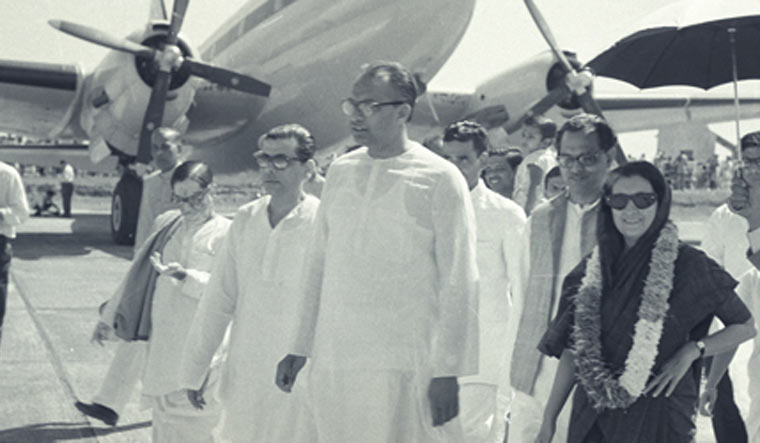
Recently, 104th birth anniversary of former Odisha chief minister Biju Patnaik was celebrated. He was a decorated freedom fighter. PM tweeted an Intelligence Bureau document from 1945 to show how Patnaik bravely lent his flying skills to rescue freedom fighters like Ram Manohar Lohia.
Biju Pattnaik
- Bijayananda Patnaik (1916-1997), popularly known as Biju Patnaik, was an Indian politician, aviator and businessman. As politician, he served twice as the Chief Minister of the State of Odisha.
- It is well known that Biju Patnaik actively helped freedom fighters in the 1940s.
- His daring was evident as he actively joined the Quit India movement in 1942 and collaborated with the underground leaders like Jayaprakash Narayan, Aruna Asif Ali and Dr. Ram Manohar Lohia, even while in the British service.
- Patnaik was imprisoned by the British Government for three years later.
Role in foreign freedom struggles
- As an officer in the Royal Indian Air Force in the early 1940s, Patnaik flew innumerable sorties to rescue British families fleeing the Japanese advance on Rangoon, the capital of Burma.
- He also dropped arms and supplies to Chinese troops fighting the Japanese and later to the Soviet army struggling against Hitler’s onslaught near Stalingrad.
- On the 50th anniversary of the end of the war, Patnaik was honoured by the Russians for his help,” the obit noted.
- Interestingly, Nehru entrusted Patnaik with rescuing Indonesian resistance fighters who were fighting their Dutch colonisers.
- Accompanied by wife Gyanwati, “the lanky pilot flew an old Dakota aircraft to Singapore en route to Jakarta where the rebels were entrenched” in 1948.
- Dodging the Dutch guns, he entered Indonesian airspace and landed on an improvised airstrip near Jakarta.
- Using left-over fuel from abandoned Japanese military dumps, Patnaik took off with prominent rebels, including Sultan Shariyar and Achmad Sukarno, for a secret meeting with Nehru at New Delhi.
Get an IAS/IPS ranker as your 1: 1 personal mentor for UPSC 2024
Attend Now
Note4Students
From UPSC perspective, the following things are important :
Prelims level: Media Access Control (MAC) Binding
Mains level: Internet shutdown as an infringement of FR
After seven months, the use of social media was allowed in Jammu and Kashmir with an order laying down the latest rules for the use of the Internet in the UT. Among various conditions, the order says Internet connectivity will be made available “with mac-binding”.
What is Mac-binding?
- Every device has a Media Access Control (MAC) address, a hardware identification number that is unique to it. While accessing the Internet, every device is assigned an IP address.
- Mac-binding essentially means binding together the MAC and IP addresses, so that all requests from that IP address are served only by the computer having that particular MAC address.
- In effect, it means that if the IP address or the MAC address changes, the device can no longer access the Internet.
- Also, monitoring authorities can trace the specific system from which a particular online activity was carried out.
Permitted connections
- The Internet can be accessed on all postpaid devices, and those using Local Area Networks (LAN).
- While the postpaid SIM card holders shall continue to be provided access to the Internet, these services shall not be made available on prepaid SIM cards unless verified as per the norms applicable for postpaid connections.
- Apart from this, special access terminals provided by the government will continue to run.
- It is further directed that the access/communication facilities provided by the government, viz. e-terminals/Internet kiosks apart from special arrangements for tourists, students, traders etc shall continue.
Only 2G permitted
- Internet speed in J&K is still restricted to 2G.
- This means very slow services — pictures will take a long time to be sent or downloaded, videos will be nearly impossible to share, and there will be a long loading time for most websites.
- It also means that although in theory, the “whitelist system” — where people could only access some websites pre-approved by the government — has been removed, some sites designed for a 4G Internet experience will hardly work.
Have curbs been lifted?
- Not exactly. The latest order is to remain in force till March 17 unless modified earlier.
- The government has been relaxing Internet and phone usage in the UTs in phases.
Get an IAS/IPS ranker as your 1: 1 personal mentor for UPSC 2024
Attend Now
Note4Students
From UPSC perspective, the following things are important :
Prelims level: Unguarded X hypothesis, Chromosomes
Mains level: NA
Men outnumbered women by 37 million in the 2011 Census of India, but among those over the age of 60, there were more than 1 million more women than men. In general, men live shorter lives than women worldwide. This is due to the chromosomal differences between the two, points’ new study.
What are Chromosomes?
- The human body is made up of cells, and in the centre of each cell is the nucleus. Chromosomes, which are located inside the nucleus, are structures that hold the genes.
- It is the genes that determine the various traits of an individual including eye colour, blood type — and sex.
- The human cell has 23 pairs of chromosomes. One pair is of the sex chromosomes, named X and Y, which determine whether an individual is male or female.
- A female has two X chromosomes (XX) while a male has one X and one Y (XY).
Unguarded X hypothesis
- This hypothesis suggests that the Y chromosome in XY is less able to to protect an individual from harmful genes expressed on the X chromosome.
- In a male, as the Y chromosome is smaller than the X chromosome, it is unable to “hide” an X chromosome that carries harmful mutations, which may later expose the individual to health threats.
- On the other hand, the hypothesis goes, there is no such problem in a pair of X chromosomes (XX) in a female.
- If one of the X chromosomes has genes that have suffered mutations, then the other X chromosome, which is healthy, can stand in for the first, so that the harmful genes are not expressed.
- This maximizes the length of life, according to the hypothesis. And this is what the UNSW researchers set out to examine.
Testing the hypothesis
- In a statement issued by UNSW, PhD student and study first author Zoe Xirocostas said the
- Unguarded X hypothesis appears to stack up, after examining the lifespan data available on a wide range of animal species.
- Researchers studied lifespan data in not just primates but mammals and birds, but also reptiles, fish, amphibians, arachnids, cockroaches, grasshoppers, beetles, butterflies and moths among others.
- It was found that across that broad range of species, the heterogametic sex (XY in humans) does tend to die earlier than the homogametic sex (XX in humans).
Get an IAS/IPS ranker as your 1: 1 personal mentor for UPSC 2024
Attend Now
Note4Students
From UPSC perspective, the following things are important :
Prelims level: Various species mentioned
Mains level: Not Much
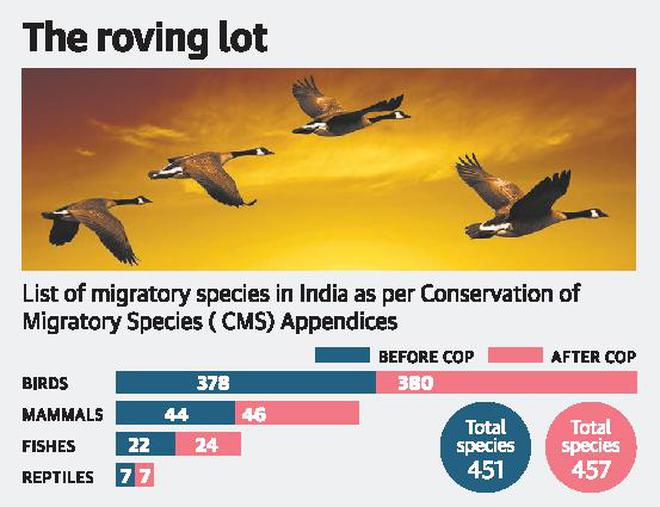
With new additions to the wildlife list put out by the Convention on the Conservation of Migratory Species (CMS), scientists say that the total number of migratory fauna from India comes to 457 species.
Migratory species in India
- Globally, more than 650 species are listed under the CMS appendices and India, with over 450 species, plays a very important role in their conservation.
- The Zoological Survey of India (ZSI) had for the first time compiled the list of migratory species of India under the CMS before the Conference of Parties (COP 13) held in Gujarat recently.
- It had put the number at 451. They are the Asian elephant, great Indian bustard, Bengal florican, oceanic white-tip shark, urial and smooth hammerhead shark.
- Birds comprise 83% (380 species) of this figure.
Various species mentioned
- India has three flyways (flight paths used by birds): the Central Asian flyway, East Asian flyway and East Asian–Australasian flyway.
- In India, their migratory species number 41, followed by ducks (38) belonging to the family Anatidae.
- The estimate of 44 migratory mammal species in India has risen to 46 after COP 13.
- The largest group of mammals is definitely bats belonging to the family Vespertilionidae. Dolphins are the second highest group of mammals with nine migratory species of dolphins listed.
- Fishes make up another important group of migratory species. Before COP 13, the ZSI had compiled 22 species, including 12 sharks and 10 ray fish.
- Seven reptiles, which include five species of turtles and the Indian gharial and salt water crocodile, are among the CMS species found in India. There was no addition to the reptiles list.
Get an IAS/IPS ranker as your 1: 1 personal mentor for UPSC 2024
Attend Now
Note4Students
From UPSC perspective, the following things are important :
Prelims level: Spectroscopy, Raman Effect
Mains level: Applications of Raman Effect
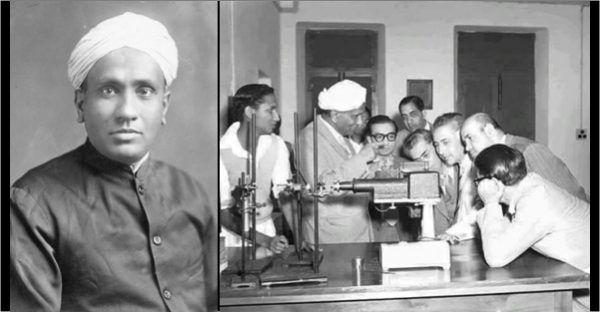
Yesterday, February 28th was celebrated as National Science Day. In 1986, the Govt. of India designated this Day, to commemorate the announcement of the discovery of the “Raman effect”.
CV Raman
- Raman conducted his Nobel-prize winning research at IACS, Calcutta.
- While he was educated entirely in India, Raman travelled to London for the first time in 1921, where his reputation in the study of optics and acoustics was known to physicists such as JJ Thomson and Lord Rutherford.
- The Raman Effect won scientist Sir CV Raman the Nobel Prize for physics in 1930.
- It was also designated as an International Historic Chemical Landmark jointly by the American Chemical Society (ACS) and the Indian Association for the Cultivation of Science (IACS).
- His speciality was the study of vibrations and sounds of stringed instruments such as the Indian veena and tambura, and Indian percussion instruments such as the tabla and mridangam.
The Raman Effect
- In 1928, Raman discovered that when a stream of light passes through a liquid, a fraction of the light scattered by the liquid is of a different colour.
- While Raman was returning from London in a 15-day voyage, he started thinking about the colour of the deep blue Mediterranean.
- He wasn’t convinced by the explanation that the colour of the sea was blue due to the reflection of the sky.
- As the ship docked in Bombay, he sent a letter to the editor of the journal Nature, in which he penned down his thoughts on this.
- Subsequently, Raman was able to show that the blue colour of the water was due to the scattering of the sunlight by water molecules.
- By this time he was obsessed with the phenomenon of light scattering.
Observing the effect
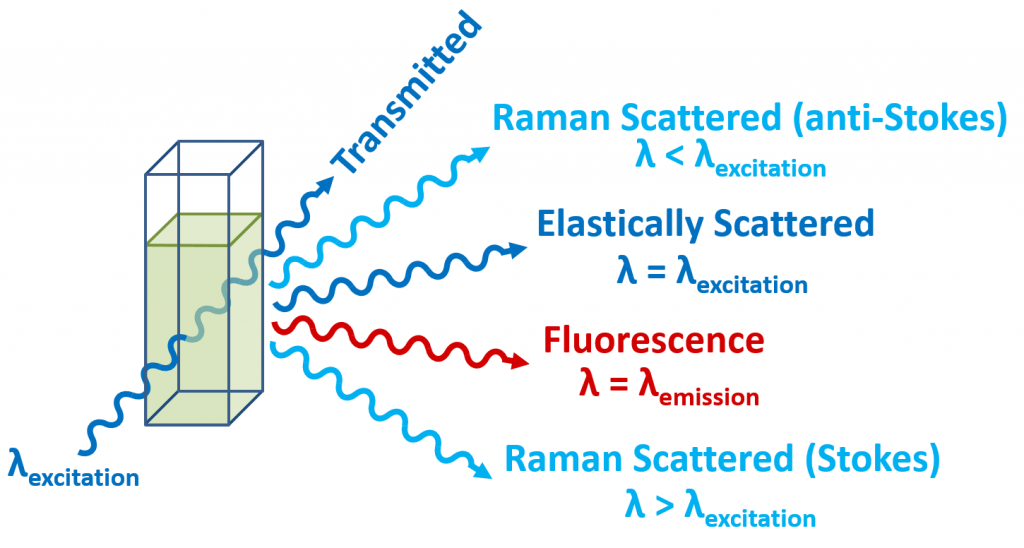
- The Raman Effect is when the change in the energy of the light is affected by the vibrations of the molecule or material under observation, leading to a change in its wavelength.
- Significantly, it notes that the Raman effect is “very weak” — this is because when the object in question is small (smaller than a few nanometres), the light will pass through it undisturbed.
- But a few times in a billion, light waves may interact with the particle. This could also explain why it was not discovered before.
- In general, when light interacts with an object, it can either be reflected, refracted or transmitted.
- One of the things that scientists look at when light is scattered is if the particle it interacts with is able to change its energy.
Applications
- Raman spectroscopy is used in many varied fields – in fact, any application where non-destructive, microscopic, chemical analysis and imaging is required.
- Whether the goal is qualitative or quantitative data, Raman analysis can provide key information easily and quickly.
- It can be used to rapidly characterize the chemical composition and structure of a sample, whether solid, liquid, gas, gel, slurry or powder.
Get an IAS/IPS ranker as your 1: 1 personal mentor for UPSC 2024
Attend Now
Note4Students
From UPSC perspective, the following things are important :
Prelims level: Red snow , How it occurs
Mains level: Impact of climate change on Antarctica

Over the last few weeks, photographs of “red snow” off the coast of Antarctica’s northernmost peninsula, have gone viral. “Red snow” or “watermelon” is a phenomenon that has been known since ancient times. Now, it raises concerns about climate change.
Red snow in Antarctica: Why it happens
- Aristotle is believed to be one of the first to give a written account of red snow, over 2,000 years ago.
- What Aristotle described as worms and grub, the scientific world today calls algae.
- This alga species, Chlamydomonas Chlamydomonas nivalis, exists in the snow in the polar and glacial regions and carries a red pigment to keep itself warm.
Signs of faster melting
- In turn, the red snow causes the surrounding ice to melt faster. The more the algae packed together, the redder the snow.
- And the darker the tinge, the more the heat absorbed by the snow. Subsequently, the ice melts faster.
- While the melt is good for the microbes that need the liquid water to survive and thrive, it’s bad for glaciers that are already melting from a myriad of other causes, the study said.
- These algae change the snow’s albedo — which refers to the amount of light or radiation the snow surface is able to reflect back. Changes in albedo lead to more melting.
Get an IAS/IPS ranker as your 1: 1 personal mentor for UPSC 2024
Attend Now
Note4Students
From UPSC perspective, the following things are important :
Prelims level: Doomsday Vault
Mains level: Not Much

The Svalbard Global Seed Vault — referred to as the earth’s ‘doomsday vault’ — now contains about 1.05 million seeds.
Global Seed Vault
- The vault — in the island of Spitsbergen, midway between Norway and the North Pole — opened in 2008 and preserves seeds for several food varieties.
- The aim of the vault is to preserve a vast variety of crop seeds in the case of a doomsday event, calamity, climate change or national emergency.
- The vault is artificially cooled at temperatures of minus 18 degrees Celsius.
- The low temperature and limited access to oxygen will ensure low metabolic activity and delay seed ageing.
- The permafrost surrounding the facility will help maintain the low temperature of the seeds if the electricity supply fails.
Access to seeds
- Vault seed samples are copies of samples stored in the depositing genebanks.
- Researchers, plant breeders, and other groups wishing to access seed samples cannot do so through the seed vault; they must instead request samples from the depositing genebanks.
- The samples stored in the genebanks will, in most cases, be accessible in accordance with the terms and conditions of the International Treaty on Plant Genetic Resources for Food and Agriculture, approved by 118 countries or parties.
Get an IAS/IPS ranker as your 1: 1 personal mentor for UPSC 2024
Attend Now
Note4Students
From UPSC perspective, the following things are important :
Prelims level: Henneguya Salminicola
Mains level: NA
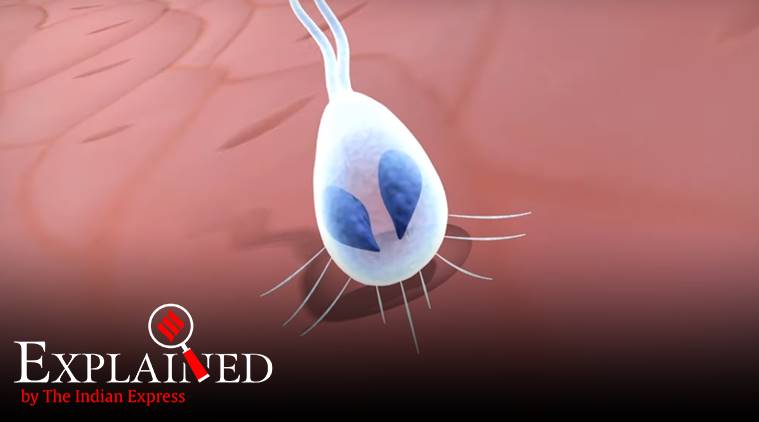
Researchers at Tel Aviv University have discovered a non-oxygen breathing animal, which significantly changes one of science’s assumptions about the animal world — that all animals use aerobic respiration and therefore, oxygen.
Henneguya Salminicola
- The organism is Henneguya salminicola, a fewer-than-10-celled microscopic parasite that lives in salmon muscle.
- It relies on anaerobic respiration (through which cells extract energy without using oxygen).
- In the case of this non-oxygen breathing organism, evolution turned it into a simpler organism that shed “unnecessary genes” responsible for aerobic respiration.
- Other organisms such as fungi and amoebas that are found in anaerobic environments lost the ability to breathe over time.
- The new study shows that the same can happen in the case of animals, too.
What is Aerobic respiration?
- Animals, including humans, need energy to perform the various tasks that are essential for survival.
- Aerobic respiration is one such chemical reaction through which organisms take in oxygen and release carbon dioxide into the atmosphere.
- Through this mechanism, energy is transferred to cells, which can use it for multiple purposes — for instance, to burn food.
- Mitochondria is the “powerhouse” of the cell, which captures oxygen to make energy — its absence in the H. salminicola genome indicates that the parasite does not breathe oxygen.
Get an IAS/IPS ranker as your 1: 1 personal mentor for UPSC 2024
Attend Now
Note4Students
From UPSC perspective, the following things are important :
Prelims level: Solar Storms
Mains level: Solar storms and their impact on Earth

According to a research, sudden releases of high-energy particles from the sun, called solar storms, can mess with the navigational ability of gray whales, causing them to strand on land.
Solar storms
- Solar storms are a variety of eruptions of mass and energy from the solar surface.
- Flares, prominences, sunspots, coronal mass ejections are the common harbingers of solar activity, as are plages and other related phenomena seen at other wavelengths.
Impact on Whales
- Solar storms have the potential to modify geomagnetic field and disrupt magnetic orientation behaviour of animals, hampering their navigation during long periods of migration.
- They disrupt earth’s magnetic field — and the whales’ navigational sense.
- The radio frequency noise created by the solar outburst affects the whales’ senses in a way that prevents them from navigating at all.
Get an IAS/IPS ranker as your 1: 1 personal mentor for UPSC 2024
Attend Now
Note4Students
From UPSC perspective, the following things are important :
Prelims level: Pakke Tiger Reserve
Mains level: Not Much

The government in Arunachal Pradesh is planning to build a 692.7 km highway through the 862 sq km Pakke Tiger Reserve (PTR). Named the East-West Industrial Corridor, the highway aims to connect Bhairabhunda in West Kameng district and Manmao in Changlang district along Arunachal Pradesh’s border with Assam.
About Pakke Tiger Reserve (PTR)
- Pakke Tiger Reserve, also known as Pakhui Tiger Reserve, is a Project Tiger reserve in the East Kameng district of Arunachal Pradesh.
- The 862 km2 reserve is protected by the Department of Environment and Forest of Arunachal Pradesh.
- This Tiger Reserve has won India Biodiversity Award 2016 in the category of ‘Conservation of threatened species’ for its Hornbill Nest Adoption Programme.
- It falls within the Eastern Himalaya Biodiversity Hotspot.
Get an IAS/IPS ranker as your 1: 1 personal mentor for UPSC 2024
Attend Now
Note4Students
From UPSC perspective, the following things are important :
Prelims level: Leap Year and the science behind it
Mains level: Not Much

The year 2020 is a ‘leap year’, meaning the month of February will have 29 days instead of 28, and the total number of days will be 366 instead of 365. This was also the case in 2016, and 2024 will again be a leap year.
Leap Years
- A calendar is meant to correspond to the Earth’s seasons.
- For this, the number of days in a calendar needs to match the time required by the Earth to orbit the Sun.
- The time required by the Earth to complete its orbit around the Sun is approximately 365.242 days. But years are usually only 365 days.
- To adjust for the extra 0.242 days in the orbital period, which becomes almost one full day in four years, the calendar adds an extra day once every four years.
- This approximates the time to 365.25 days, which is close to the actual 365.242 days.
But is that not inaccurate?
- Yes, it is. And further adjustments are made to the Gregorian calendar, the calendar we follow today.
- The Gregorian calendar was introduced in 1582. Before that, the calendar followed was the Julian calendar, introduced in 45 BC.
- The calendars were different in their treatment of leap years.
- The Julian calendar had leap days every four years, but since it still did not accurately conform to the Earth’s precise orbit time, it kept falling behind with respect to natural seasons over the centuries.
- By the 16th century, the Julian calendar had fallen out of tune with the natural seasons by almost 10 days.
- To correct this discrepancy, Pope Gregory XIII in 1582 decreed that the day of October 4 that year would be followed directly by October 15 – thus covering up the error.
- The Pope also modified the leap year system in the Julian calendar. That new system came to be known as the Gregorian calendar.
What is the new system?
- In the Gregorian calendar, a century year (a year ending with 00) is not a leap year, even though it is a multiple of 4. Thus, the year 2100 will not be a leap year.
- But even this does not provide total accuracy. To ensure that, some century years remain leap years. In the Gregorian calendar, leap years include those century years which are exactly divisible by 400.
- Thus, 2000 remained a leap year even though it ended with 00.
- The Gregorian calendar reduces the margin of error under the Julian calendar, thus keeping days more in tune with seasons.
Get an IAS/IPS ranker as your 1: 1 personal mentor for UPSC 2024
Attend Now
Note4Students
From UPSC perspective, the following things are important :
Prelims level: Harappan food pattern
Mains level: Not Much
The National Museum in New Delhi has hosted “The Indus dining experience” a food event based on the food pattern of Indus valley civilization.
Food of Harappans
- Archaeological evidence from Indus Valley sites (c. 3300 BC to 1300 BC) in present-day India and Pakistan suggests that a purely vegetarian meal will not provide a complete picture of what the Harappan people ate.
- To judge from the quantity of bones left behind, animal foods were consumed in abundance: beef, buffalo, mutton, turtles, tortoises, gharials, and river and sea fish.
- Apart from meat, the people of the Indus Valley Civilisation grew and ate a variety of cereals and pulses.
- There is archaeological evidence for cultivation of pea (matar), chickpea (chana), pigeon pea (tur/arhar), horse gram (chana dal) and green gram (moong).
- Several varieties of wheat have been found at Harappan sites, as well as barley of the two-rowed and six-rowed kinds.
- There is evidence that the Harappans cultivated Italian millet, ragi and amaranth, as well as sorghum and rice.
- Oilseeds such as sesame, linseed, and mustard were also grown.
Get an IAS/IPS ranker as your 1: 1 personal mentor for UPSC 2024
Attend Now
Note4Students
From UPSC perspective, the following things are important :
Prelims level: Spontaneous healing/regression
Mains level: Not Much
Patients sometimes make ‘miraculous’ recoveries from severe ailments. This is called spontaneous healing or spontaneous regression.
Spontaneous healing/regression
- A patient improves unexpectedly from a disease that usually progresses, such as cancer, and at times is even cured.
- Such cases notwithstanding, the medical fraternity is often sceptical and takes “miraculous” recoveries as flukes.
- A research explores patterns behind healing illnesses such as the deadliest kinds of cancers, and lays out physical and mental principles associated with recovery.
- These include physically healing diets and immune systems, and mentally healing stress responses and identities.
How does it occur?
- The research states that much of our physical reality is created in our minds and perception changes our experiences, sometimes to the point of changing our bodies.
- Therefore it argues that healing our identities may be a key tool to recovery.
Get an IAS/IPS ranker as your 1: 1 personal mentor for UPSC 2024
Attend Now
Note4Students
From UPSC perspective, the following things are important :
Prelims level: Meghalayan caves, and their biodiversity
Mains level: NA

Systematic exploration of the Meghalayan caves has been underway for almost 30 years and hundreds of kilometres of cave passages have been explored and mapped. In a cave in a remote forested area of Meghalaya’s Jaintia Hills a research expedition found large specie of a subterranean fish (occurring under the earth’s surface).
About the fish
- The blind fish was over 40 cm. It has not been named so far.
- It is nearly five times the mean length (85mm/8.5 cm) for all known subterranean fish to date.
- The only other species exceeding 300mm (30 cm) in length are eel-like Synbranchidae with nothing like the bulk of the new fish.
- The 250-known subterranean (occurring under the earth’s surface) fish species around the world measure only around 8.5 cm on average.
- The specialists say that possibly one (or more) populations of these fish became isolated deeper in the caves and over generations became adapted to the dark, losing their eyes in the process.
Closest resemblance
- The experts feel that the fish species is very similar to the Golden Mahseer or the Tor Putitora, one of the most famous game fish of the Himalayan rivers.
- Unique characters that distinguishes it from the Golden Mahseer is the lack of pigmentation, a lack of eyes and of course, its subterranean habitat – being locked in caves.
- There are ‘normal’ Golden Mahseer in the area too but there is not much surface water (at least in the dry winter months) so fish end up in the cave pools and underground rivers.
Features of Subterranean ecosystems
- Subterranean ecosystems are considered extreme, high-stress environments characterised by darkness, truncated food webs and food scarcity.
- Despite this, they harbour exceptional vertebrate and invertebrate taxa (21,000+ species), many of which are evolutionarily unique, and relics of ancient fauna given their long-term isolation.
- Many cave fish show different adaptations – some don’t have eyes, some have reduced eyes, some don’t have fins, some have weird body shapes.
Get an IAS/IPS ranker as your 1: 1 personal mentor for UPSC 2024
Attend Now
Note4Students
From UPSC perspective, the following things are important :
Prelims level: State of Rampur
Mains level: Post independence consolidation and reorganization
Erstwhile royals of the state of Rampur in Uttar Pradesh are fighting over the assets and legacy of Nawab Raza Ali Khan, who acceded to the Indian Union at the time of Independence. The Supreme Court ended India’s longest-running civil dispute last year, and the process of evaluating the inheritance is currently ongoing.
The state of Rampur
- The state of Rampur was founded by Nawab Ali Muhammad Khan, the adopted son of Sardar Daud Khan, the chief of the Rohillas in Northern India.
- The Rohillas were Afghans who entered India in the 18th century as the Mughal Empire was in decline, and took control of Rohilkhand, at the time known as Katehr.
- In 1737, Nawab Muhammad Khan received the territory of Katehr from Emperor Muhammad Shah, only to lose everything to Nawab Wazir of Oudh in 1746.
- Two years later, he assisted Ahmad Shah Durrani in his conquest of India, recovering all his former possessions.
- Over the next two centuries the Rampur royals, earlier a warring clan, struck deep roots, and with the blessings of the British, began to build one of the richest principalities in the country.
Patrons of the arts, culture
- The Rampur royals have played an important role in the socio-cultural history of the Ganga-Yamuna belt.
- They run the Amir Raza library in Rampur, once known as the official darbar of the Nawab, which is home to some 15,000 manuscripts in Arabic, Urdu, Persian and Turkish, as well as a seventh-century Quran.
- The library also houses 2,500 specimens of Islamic calligraphy, 5,000 miniature paintings, and 60,000 printed books, besides the extremely rare Persian translation of Valmiki’s Ramayana, which is believed to have been Emperor Aurangzeb’s personal copy.
- In the 19th century, the royals established courts of law and a standing army, and built irrigation works. In the 20th century, they set up sugar and textile mills.
- Many Hindus were employed in senior administrative positions in the state. Nawab Raza Ali Khan was known to have written poetry in Bhojpuri for Holi.
- The Rampur court was also a great patron of the arts, and is known to have patronised Ghalib and Begum Akhtar, as well as the tabla player Ahmad Jan Thirakwa, sarangi player Bundu Khan, sarod player Fida Hussein Khan, been player Wazir Khan, and the kathak dancers Acchan Maharaj and Kalka Prasad.
After Independence
- Rampur, under Nawab Raza Ali, was the first kingdom to accede to India in 1949, becoming the only Muslim-majority district in Uttar Pradesh.
- Soon after accession, the Nawab handed over the official royal residence, the Rampur Qila or Fort, built in 1775, to the Indian government, along with several other properties.
- In return, the Indian government bestowed two key rights to the Nawab — he was granted full ownership of the properties, and guaranteed succession to the gaddi or rulership of the state based on customary law, which gave exclusive property rights to the eldest son.
- When Raza Ali Khan died in 1966, he had three wives, three sons, and six daughters.
- His eldest son Murtaza Ali Khan succeeded him as head of the state, as per custom.
- The government recognised him as the sole inheritor of all his father’s private properties and issued a certificate to this effect. But his brother challenged this in the civil court.
Get an IAS/IPS ranker as your 1: 1 personal mentor for UPSC 2024
Attend Now













